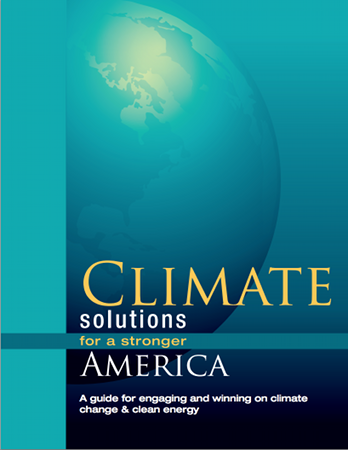How to Talk About Climate Change
A couple of interesting how-to type things I can recommend for people (like me) who sometimes want to try to talk persuasively, in particular about climate change (though I think the advice is good for pretty much anything one wants to communicate).
First up, Joe Romm’s new book really is quite good. I already mentioned it briefly in a previous item, but here it is again (repetition!) with a picture:
Second, several people in my newsfeed (most recently David Roberts) have mentioned the new pamphlet from Betsy Taylor of Breakthrough Strategies, Climate Solutions for a Stronger America: A Guide for Engaging and Winning on Climate Change & Clean Energy (PDF).
At first I thought it was from the Breakthrough Institute, and as a result I passed on actually reading it. It’s not that I have any strong feelings against the Breakthrough Institute, but I have gotten the feeling that there’s a particular set of solutions they’re pushing, and the knowledge that I’d need to be on guard against being oversold by someone with a vested interest in selling me served as a disincentive. But knowing that David Roberts liked it caused me to look closer, and I realized that no, Breakthrough Strategies and the Breakthrough Institute appear to be completely different people.
Anyway, both items get my personal stamp of approval.
Update: Another interesting item on communicating about climate change. From Matthew Nisbett of the Age of Engagement blog: NPR News on Framing Global Warming as a Public Health Threat.
Nisbet also warns that messaging around climate change can become “deactivating” for people, not just if it evokes anger, but if it leaves people without a sense of hope for a solution, or if the problem seems too complex to address. He says that respondents in the “alarmed,” “concerned” and “cautious” categories react with hope to all three frames, but that people in the “disengaged” category react much more positively to the public health frame than the national security or environmental frame. “They see it as something within their realm of control, something that can make their lives better.”
For that reason, in communicating about climate change, Nisbet says, advocates need to be careful not to “present the danger as being so threatening that it feels overwhelming to people. Whenever you give people information about the risk of climate change, if you don’t provide specific things they can do about it, they can become fatalistic, or just deny the threat. That’s been a problem with some of the environmental messaging around climate change.” Those specific action items, the research suggests, could include policies to make energy sources cleaner, to make cars and buildings more energy-efficient, to make public transportation more accessible and affordable, to improve the quality and safety of food, and to make cities and towns friendlier to cyclists and pedestrians.


